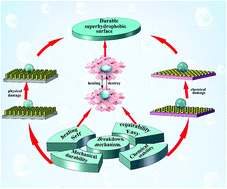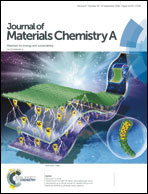Biomimetic super durable and stable surfaces with superhydrophobicity
Abstract
Owing to their specialized functions and various potential applications, bioinspired superwettable surfaces have captured much attention. Nevertheless, superhydrophobic surfaces are vulnerable to destruction under various harsh conditions when applied in industry and life science, limiting larger-scale applications. Herein, the subject of prolonging lifetime is comprehensively discussed by means of analyzing the breakdown mechanism, which is influenced by the parameters of surface structures. First of all, the mechanical durability of surfaces can be highly enhanced to endure mechanical damage, through introducing elastic materials and exceptionally stable rough structure. Secondly, chemically stable superhydrophobic coatings are introduced to resist UV ultraviolet irradiation, acid/base/salt solutions and high temperatures. Thirdly, a certain number of vital advances are summarized regarding surface self-healing properties, which can greatly prolong the service life of surfaces through releasing low surface energy agents and regenerating topographic structures. Last but not least, the easy repairability of superhydrophobic coatings is beneficial for chemical damage resistance on account of the fast restoration of original characteristics. Conclusions and outlooks concerning constructing super stable and durable bioinspired superwettable surfaces are revealed and discussed in this review, aimed at extending the application of these surfaces to our daily life and industrial manufacture.

- This article is part of the themed collection: Recent Review Articles


 Please wait while we load your content...
Please wait while we load your content...